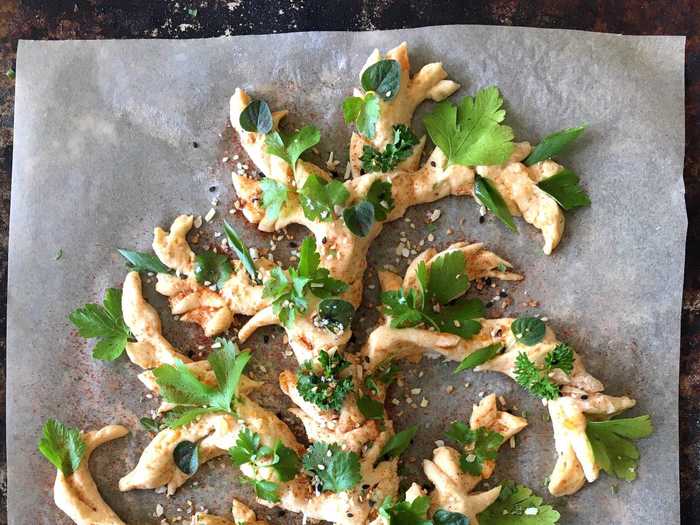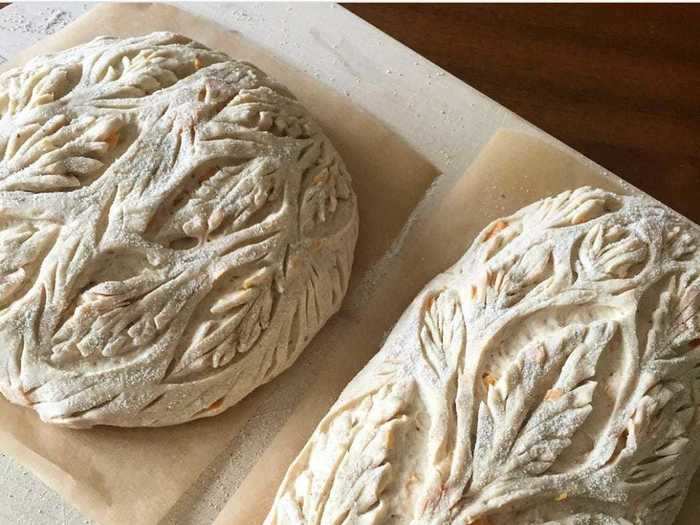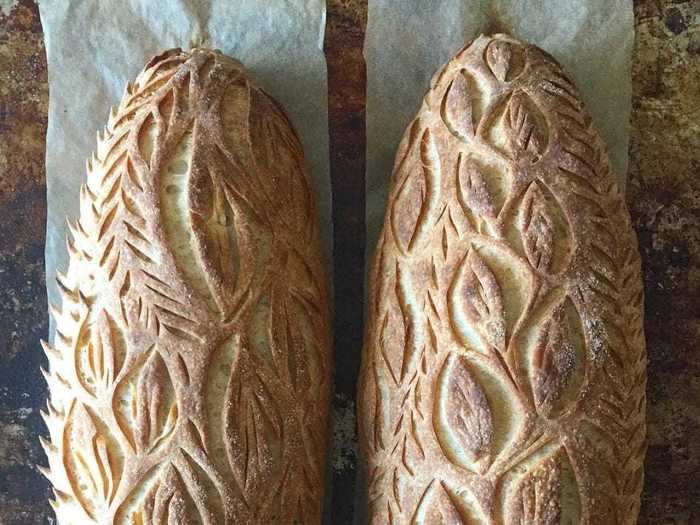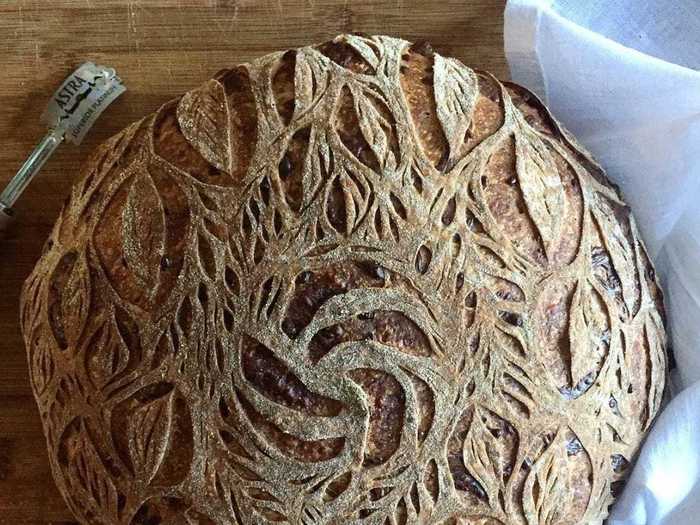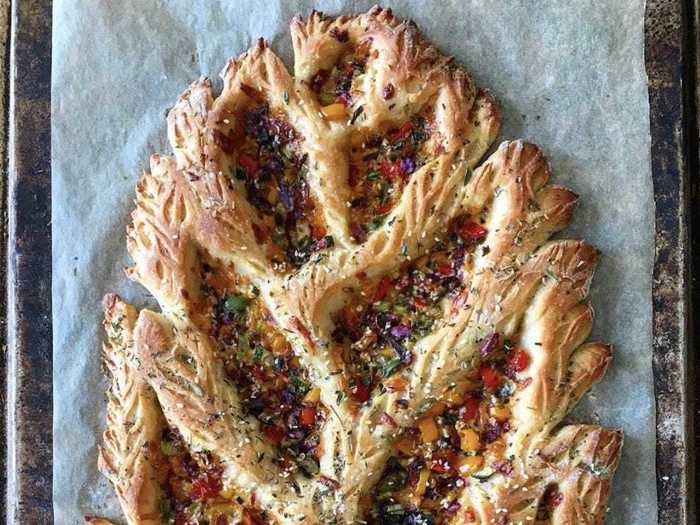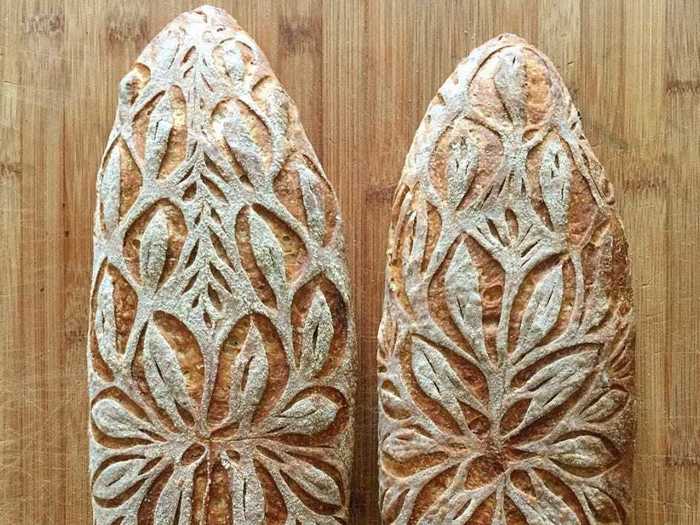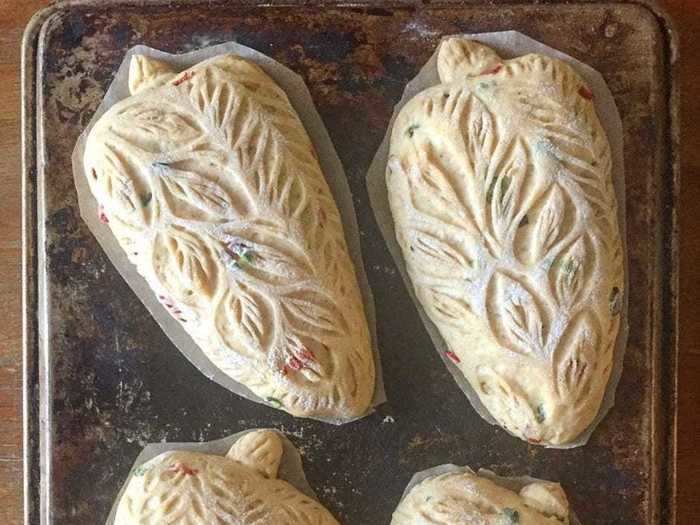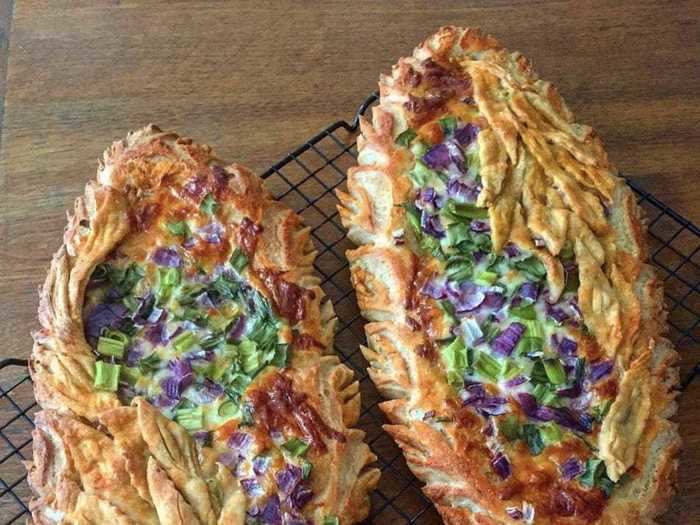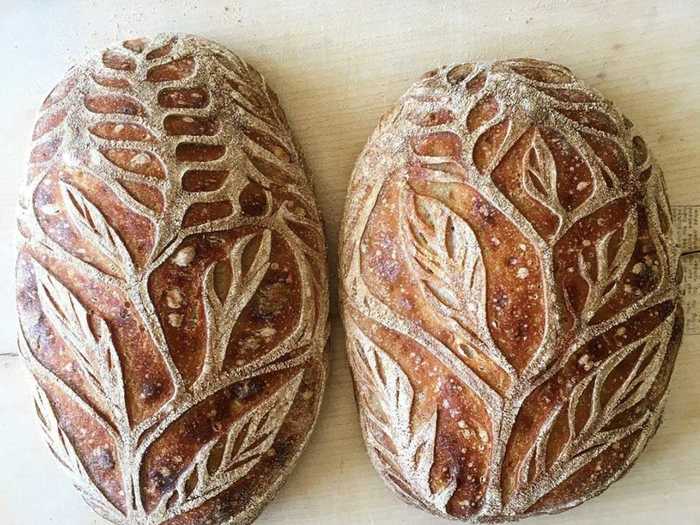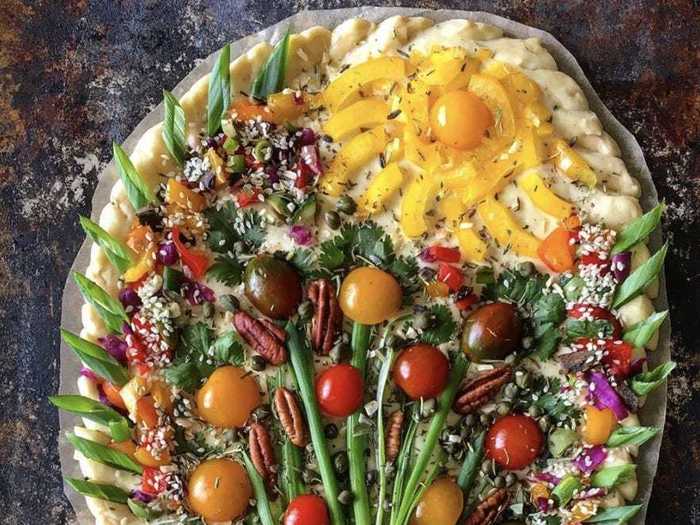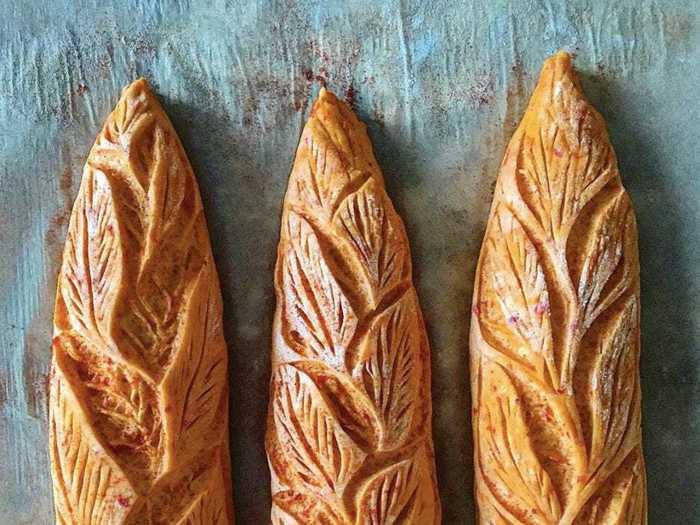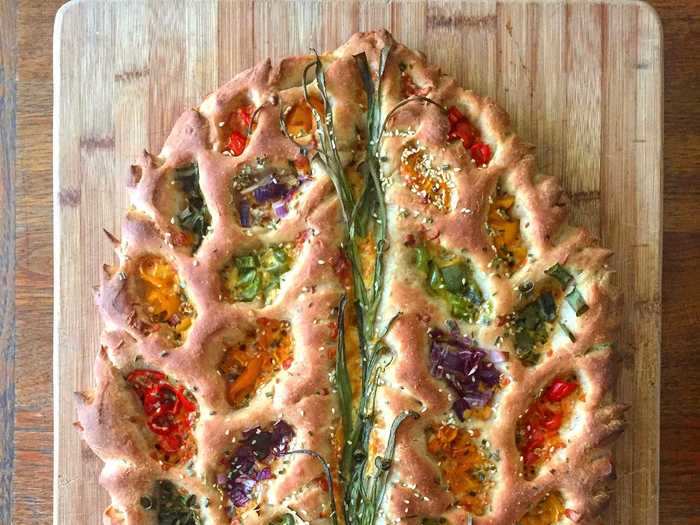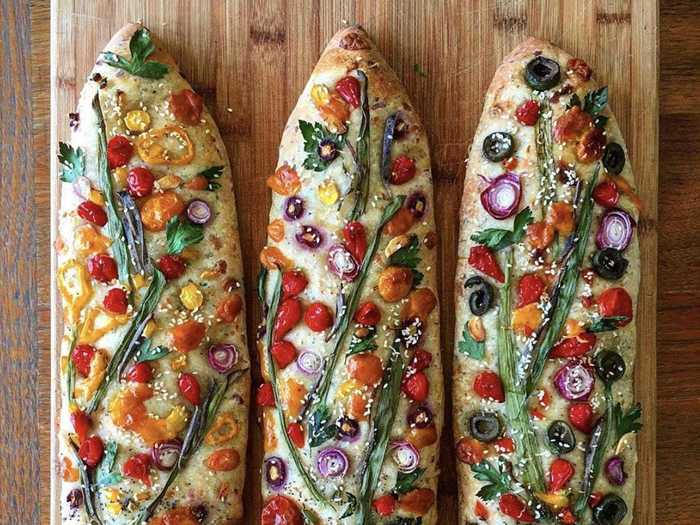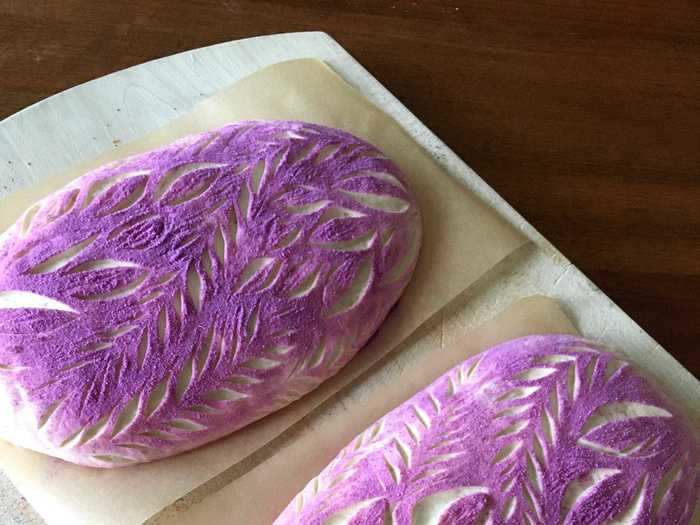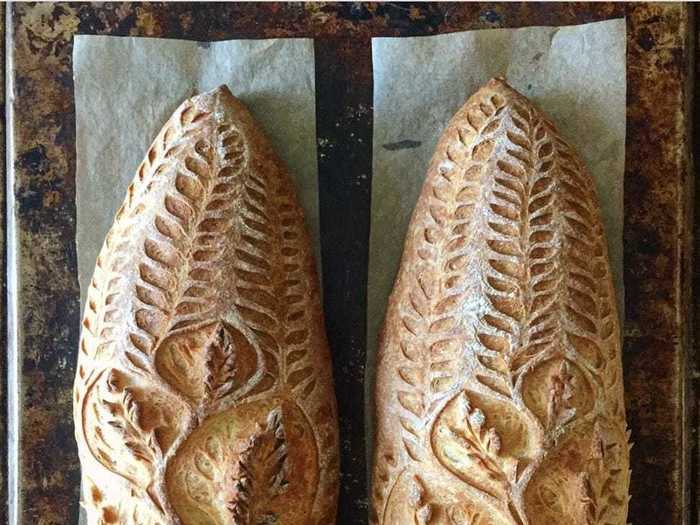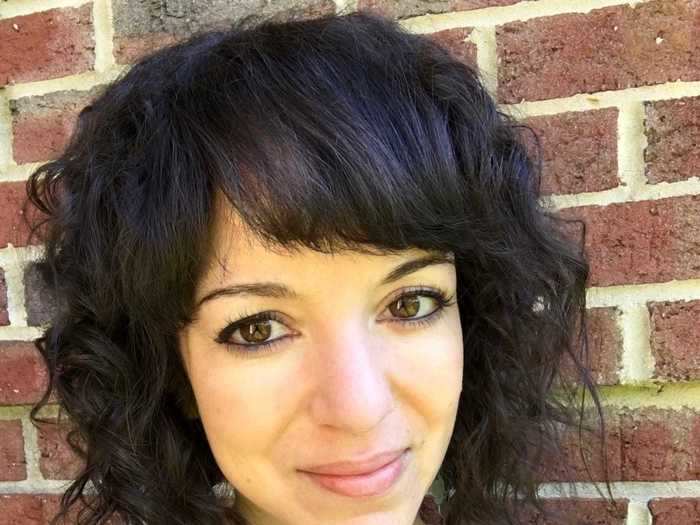Hannah Page has been making incredible bread art for the last six years.Hannah Page - Hannah Page has been creating beautiful bread art for the last six years, posting her pictures on the popular Instagram page Blondie + Rye.
- The North Carolina baker creates beautiful designs on the crust, or uses vegetables and taro powder to add gorgeous bursts of color.
- Page works almost exclusively with sourdough, which she became passionate about after learning how to make her own starter.
- The high school history teacher told Insider that she has chosen to keep bread-making a hobby instead of making it her full-time career because she finds it relaxing.
- Visit Insider's homepage for more stories.
Nowadays, it seems like everyone is speaking in sourdough, filling up our Instagram stories and grids with picture after picture of beautifully baked bread.
But come across Hannah Page's profile and you'll see more than just pretty loaves. You'll notice the intricate leaves weaving through the length of a baguette, the flowers expertly carved into the crust. Sometimes, there will be great big bursts of color, a rainbow of vegetables or taro powder.
Page is behind the popular Instagram account, Blondie + Rye, where the self-taught baker is constantly transforming baguettes and boules and buns into beautiful works of art.
Insider spoke with Page to find out how her passion for baking first began, why she became dedicated to bread art, and her tips for those who are just beginning their journey with sourdough.
Read the original article on
Insider
But Page said her most important tip is to remember that anyone can create beautiful art with bread.
Page believes that anyone can master the art of bread-making.
Hannah Page
"Everyone can dip in and make their bread pretty and have it as part of their life on a regular basis," she said. "For me, it just started with how fun it is to create something pretty, but it's this pretty thing that can also be torn apart and eaten and create nourishment for people. You've got this canvas and you just kind of rip into it, which is cool."
"It's really more of an everyday art," she added. "Not in a gallery, but in your kitchen."
If you're hoping to teach yourself the art of scoring, Page said the most important tool you can order for yourself is the lame.
Page almost exclusively uses a lame to score her loaves.
Hannah Page
If you can't obtain a lame at the moment, there are ways to get creative with a coffee stirrer or a shish kebab skewer.
"You need to be able to slide a double-edged razor or something flat and long, and you can use just that to score," she said. "All you need is a razor blade, and maybe a pair of scissors."
If you're ready to take the sourdough plunge but can't find the ingredients to make starter from scratch, Page suggests calling local bakeries to see if they have any that they're willing to sell or give away.
Calling local bakeries can be a great way to get sourdough starter.
Hannah Page
For those who are just starting out, Page recommends learning with commercial yeast instead of going straight to sourdough.
If you're a bread beginner, Page recommends starting with commercial yeast.
Hannah Page
"Starting with commercial yeast is best, that's what I did," she said. "Simple no-knead recipes help you get a sense of the stages of bread-making — that idea of a first rise and bulk fermentation and a second rise."
Page believes that bread-making is the "perfect quarantine activity," and said many people have told her it's been on their bucket list for a long time.
Page said the current quarantine is a perfect time to learn the art of bread-making.
Hannah Page
"You're finding something on your bucket list that's doable at home," she said. "It's not just learning one recipe and finally making that soup you wanted to make, it's a skill."
"And if you're baking at home for your family, you're wanting to do something that can nourish them. Bread is something that you would buy normally that you want to learn how to make, so I think that's part of it."
Page currently can't break bread with her loved ones during quarantine, but she has been sharing her love with many who are just beginning their own bread journey.
And Page is excited to see so many people picking up bread-making in quarantine.
Hannah Page
"It's going to be really interesting to see what happens in the wake of this and as we come through this together as a society," she said.
"Do we end up with a whole new generation of bread bakers? That would really be something."
When people around her are going through a hard time, Page always makes sure to bring them a loaf of bread.
Page loves being able to share her homemade bread.
Hannah Page
"It's different from bringing a plate of brownies," she said. "Most people aren't bringing fresh bread, so it's something kind of unique to offer your friends and family that feels really nourishing."
"If someone's having a really hard month at work I'm always like, 'You're getting a bread.'"
One of Page's greatest joys has been sharing bread with the people she loves, from her family and friends to her students and neighbors.
Page said she finds bread-making to be "meditative."
Hannah Page
"I like bringing bread to students, and they're one of the most appreciative bunches. I always make jokes that they're a pack of ravenous wolves. I turn around and it's just crumbs," she said. "They help me experiment and give me feedback."
"Baking for the community is really fun too," Page added. "We used to bring it down to our local brewery. I give them some bread, we get some beer. Trading fermentation for fermentation."
That meditative feeling is the very reason why Page loves baking sourdough, a long process that requires a lot of patience.
Page said she doesn't plan to turn her bread-making hobby into a full-time career.
Hannah Page
"With sourdough, you have to be near it and waiting, you have to be watching that dough," she said. "Early on, I'd check on my dough in the middle of the night. It will kind of take over your mind because it just becomes this cool thing that you created with your own hands."
"For so long, bread has been the core of the meal for so many cultures and people," she added. "If you have good bread, you pretty much have what you need."
As Page's talent — and Instagram following — grew through the years, many people asked why she didn't turn her hobby into a full-time career.
Page started her popular Instagram page nearly four years ago.
Hannah Page
But for Page, baking bread is about far more than posting pretty pictures on social media. It's meditative.
"The process of baking bread is a way for me to decompress," she said. "I'm a very early riser, I almost exclusively do it in the morning when no one else is awake and it's just me. It has become part of my morning ritual."
Page said she would be "very hesitant to lose" the part of bread-making that is "decompressing" for her.
As she continued working on her bread designs, Page realized she was tapping into an artistic side that she didn't even know she had.
Page often improvises the designs she makes on her loaves.
Hannah Page
"I've actually never been artistic at all," she said. "I've been quite clumsy at art in my past. My sister is very good at visual art, she's very good at drawing, but I've never been very good at those things.
"It was strange to find something artistic that I felt I was good at."
Page doesn't often write down her recipes and instead makes decisions as she goes, based on what ingredients she has.
Page said she didn't know she had an artistic side before she began baking.
Hannah Page
"It's literally just this is the flour I have, this is the ingredients I have, I'm going to calculate what I can do in my head and I just do it," she said. "I'm not imprecise, I'm not just throwing flour into a bowl, I use a scale. I just don't keep as good a track of what I do."
"It's part of what I like about it, it's kind of riffing," Page added. "The improvisation is something I value about it."
And while many bakers will create or use stencils for their crust designs, Page said she almost exclusively uses her lame.
Page has even made sourdough matzah.
Hannah Page
"It's a simple implement with a double-edged razor on the end, which is extremely sharp and I have to be very, very careful with it," Page said. "That is really the tool for any kind of cut on the loaf."
"I also use very sharp kitchen scissors a lot. There's a lot you can do with bread and scissors."
While many of her designs may look intricate, Page said she doesn't do much planning before she begins baking.
Page often uses vegetables to add color to her designs.
Hannah Page
"The truth is, I don't always know where they're coming from when I first start," she said. "A part of what you're figuring out when you're scoring is if your design will bloom well in the oven, or if it will rip apart and not look as pretty. You have to think about it ahead of time, ideally, but a lot of the time I don't go in with a whole lot of plans."
Page said that she looked at books of designs early on to "get the sense of the mechanics," but quickly began riffing on the classic French scoring techniques that she was seeing in the pages.
Now, she often draws inspiration from "the whimsical expressions of what you might see in nature," covering her loaves in gorgeous patterns of leaves and flowers, or creating entire gardens on the crust.
Page began baking bread every single day, and soon found herself scoring — the technique of slashing bread dough with a knife or lame before baking it — all of her dough.
Page used taro powder to give these loaves their burst of color.
Hannah Page
"I don't remember exactly when I started doing the designs, but it was fairly early on," she said. "It was no more than a year in that I began getting interested in what they look like, and not just what they taste like."
"I would find myself doodling the scoring designs on anything. On my planner, on bills, on notebooks. Where I should've been taking notes at faculty meetings, I'd have designs."
But it wasn't until Page began experimenting with sourdough that she truly became passionate about baking bread.
Page now almost exclusively works with sourdough bread.
Hannah Page
Everything changed when, about six months into her baking journey, Page made her own sourdough starter — the fermented yeast dough that allows the sourdough to rise.
"You can be into baking bread, but once you actually make your own starter that you create from scratch and use over and over for the rest of your life, that's when it hits," she said. "Because you're creating this out of nothing, it becomes part of every loaf you make. My starter has microbes that no one else's does. There's people who have starters from the mid-19th century. It's crazy to think that you could keep passing it down and giving it to people."
"Once I made my own starter and figured out how to bake with it, that's when I didn't look back."
Hannah Page first began baking bread six years ago, when a coworker gave her a Dutch oven as a wedding present.
Page has been baking bread for the last six years.
Hannah Page
Inside the oven was a handwritten version of the no-knead bread recipe by Jim Lahey, the owner of the legendary Sullivan Street Bakery in New York City. The recipe had been shared by The New York Times food writer Mark Bittman in 2006, and quickly took the home-baking world by storm.
Page, who teaches history at a high school in Raleigh, North Carolina, would soon follow.
"That was my first taste of general bread baking, and that was using commercial yeast," she told Insider.

